Strawberries, Fragaria × ananassa, are low-profile, fruit-bearing perennials suited to cultivation in USDA Hardiness Zones 3 to 10.
Sometimes considered a challenging crop, folks in cold regions with freezing winters often grow plants as annuals and discard them at season’s end.
However, when you select the hardiest cultivars, and provide a little pre-winter TLC, your favorite berry-makers can yield sweet and tasty treats year after year.

We link to vendors to help you find relevant products. If you buy from one of our links, we may earn a commission.
In our comprehensive guide to growing strawberries, we cover all you need to know to plant, care for, and harvest strawberries.
In this article, we focus on a few easy steps to take to winterize plants so they return with vigor each spring.
Here’s the lineup:
What You’ll Learn
There’s a chill in the air. Let’s get started!
Why Winterize?
Most types of strawberry require 200-300 chill hours with temperatures between 45 and 32°F for optimal fruit production.
However, according to Emily Hoover, extension horticulturalist at the University of Minnesota Extension, temperatures of 15°F or below can cause fatal damage to the crown.
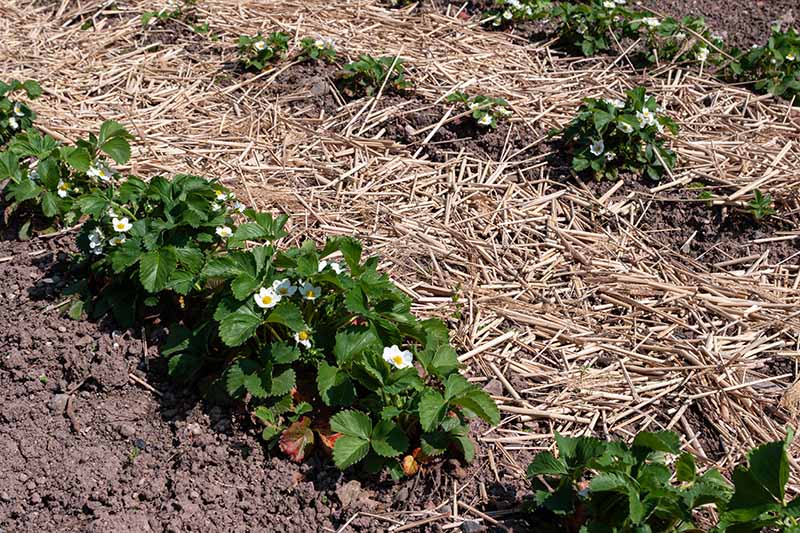
If you live in a region where the ground freezes in winter, your strawberries will benefit from a few proactive measures to help them survive the coldest months of the year.
There are four reasons why:
- To avoid damage to next spring’s buds.
- To minimize root damage from temperature fluctuations caused by repeated cycles of freezing and thawing.
- To inhibit “heaving,” a spontaneous uprooting caused by soil shifts during freezing and thawing.
- To retain the moisture needed to keep crowns – the part of the plant where the stems originate – from drying out.
With a bit of preparation, you can protect your plants from the ravages of winter and set them up for a healthy return after their period of dormancy.
Container-grown plants can be prepared using the same methods described below and then placed in a basement, shed, or garage to winter over.
Four Easy Steps
The four steps to prepare strawberries for winter are: renovate, fertilize, water, and apply mulch.
Let’s look at each step in more detail:
1. Renovate Your Plants
There are three types of strawberry plant:
- June-Bearing varieties that form buds in the fall, bloom in spring, and produce one large harvest, typically in June.
- Everbearing varieties that form buds when the days are long, and produce three harvests each year.
- Day-neutral types that will flower and produce fruits throughout the growing season provided temperatures don’t go lower than 35°F or over 85°F.
After harvesting fruit, plants that are expected to winter over need to be renovated. This process consists of pruning foliage, thinning, and removing debris and weeds.
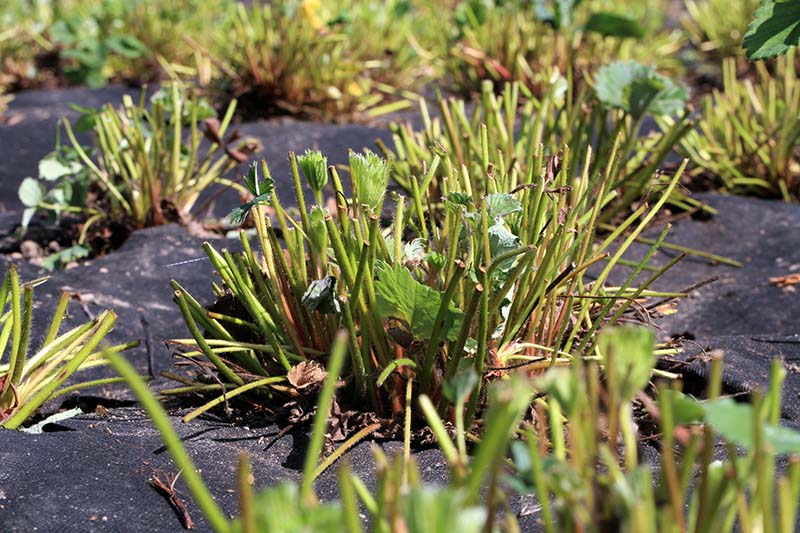
For June-bearing varieties, you’ll need to prune the foliage to a height of one to two inches above the crown. You can do this with pruning shears or hedge clippers.
If you have a large flat strawberry patch, you can also use a lawn mower with the blade set to the appropriate height, but be sure to mow no more than one week after the last harvest or you risk damaging the new leaves.
Thin plants that have spread and matted together to rows eight to 12 inches wide, with two to three feet between them.
Remove runners as needed to contain your plants to their target width. You may use a tiller for this task.
If they are not growing in rows, thin them to five per square foot, or about four to six inches apart.
Discard all those that have been weakened by adverse weather conditions, disease, or infestation by pests.
Remove any weeds and debris.
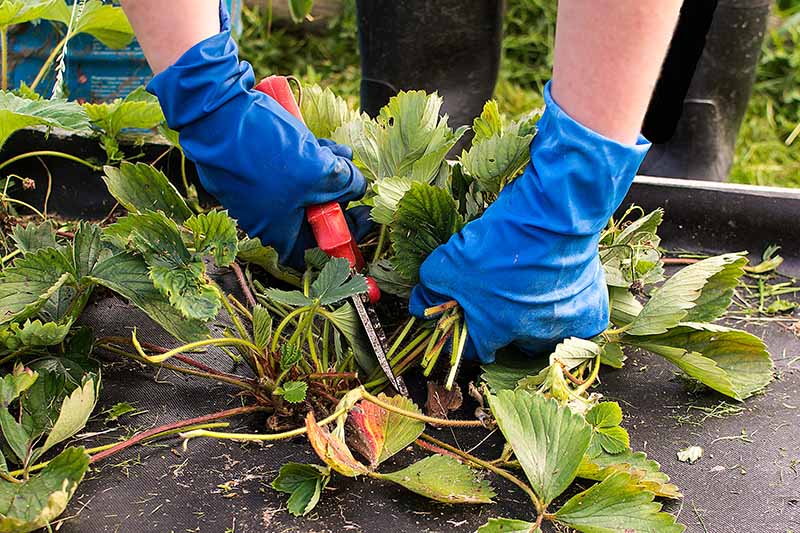
For everbearing and day-neutral varieties, prune off any leaves that appear damaged, diseased, or pest-infested. Remove entire plants if necessary.
Thin those remaining to five per square foot, or about four to six inches apart.
Remove runners to prevent the growth of new plants and remove any weeds and debris.
Be sure to discard diseased and pest-infested foliage in the trash, not on the compost heap.
2. Fertilize
Outreach Horticulturist Richard Jauron from the Department of Horticulture at the Iowa University Extension recommends the application of a balanced, 10-10-10 (NPK) fertilizer at a quantity of five pounds per 100 feet of row, or one pound per 25 plants at least one month before your average first frost date.
Take care to avoid direct contact with foliage, apply granular fertilizer or pellets between plants in beds and containers, and in the aisles between the rows. Water in well.
3. Water
After you have renovated your plants, continue to water right up until first frost. Provide one inch of supplemental water per week in the absence of rain.
During the cold months, while they are dormant, there is no need to provide supplemental irrigation for those growing in the garden.
Container-grown plants placed in a cold shed or garage will require minimal water, just enough to prevent the soil from drying out completely.
4. Apply Mulch
Mulch is the final step toward winter readiness. An application of mulch provides a layer of insulation that is especially important in regions with little to none of nature’s own insulation: snow.
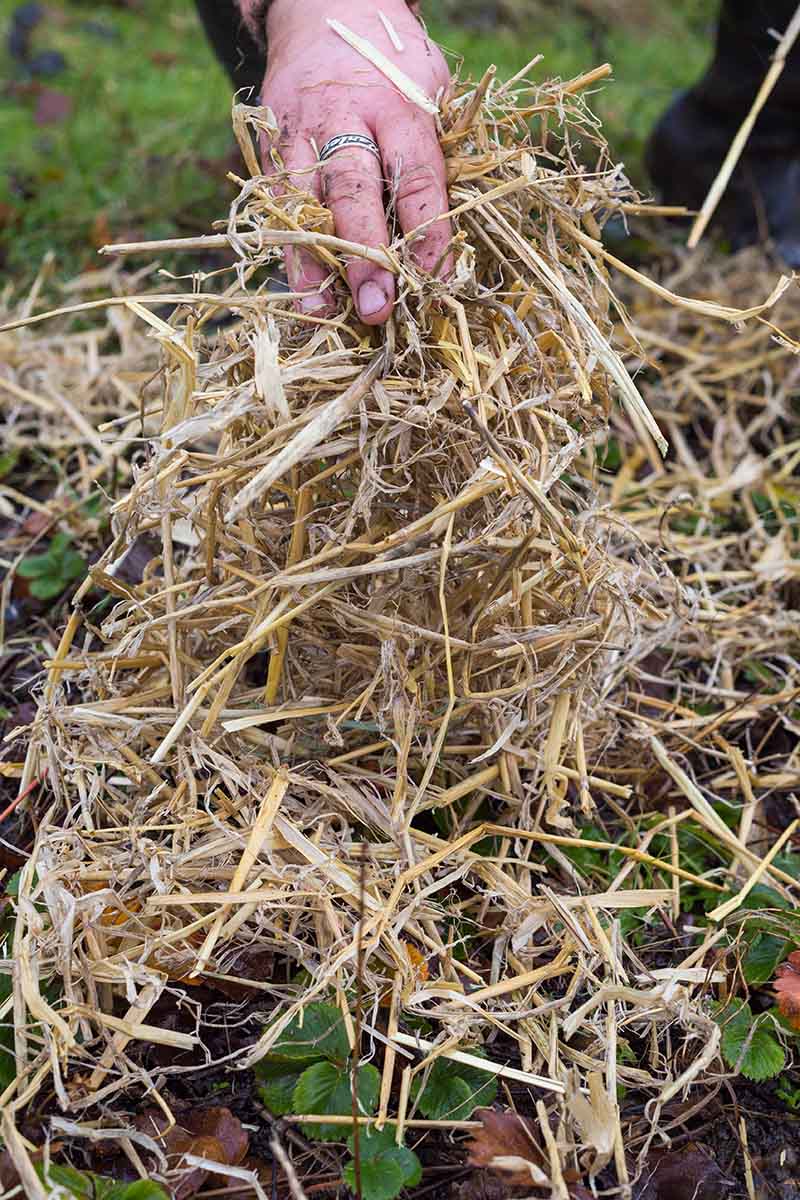
Covering plants not only helps to keep them uniformly cold during temperature fluctuations, it aids in retaining the moisture essential to crown health, while also promoting optimal drainage.
Timing
The application of mulch is not something to be rushed for three reasons:
- Laying it too soon may raise the ground temperature and promote new growth.
- It may trap excessive moisture that can rot crowns.
- It may attract mice and other rodents that are still actively seeking winter shelter.
The best time to apply mulch is between late November and early December, after first frost when much of the foliage is brown and floppy, and before temperatures drop below 20°F.
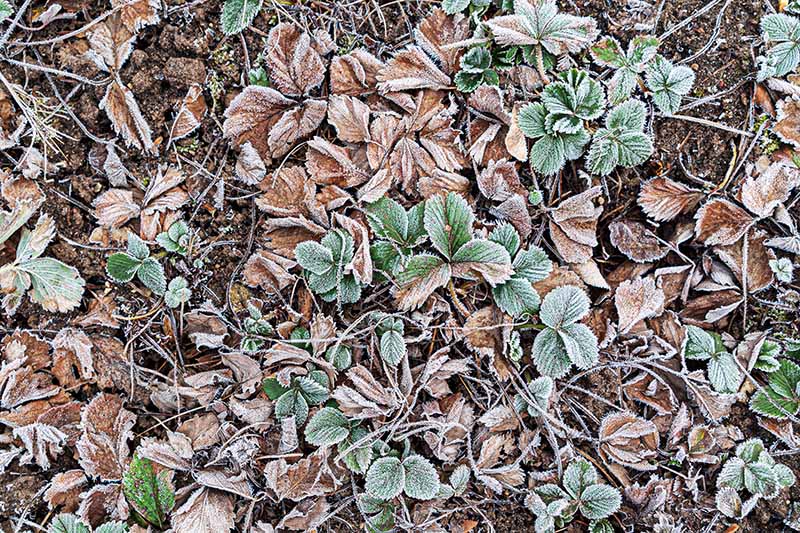
As mentioned earlier, at 15°F, plants not covered by mulch or snow are susceptible to fatal crown damage.
Application
Choose a mulching material that is loose to avoid matting, facilitate air circulation, and aid in drainage.
Straw or pine needles are excellent choices. Avoid leaves and grass, as they are likely to mat, as well as hay, because it tends to be full of weed seeds.
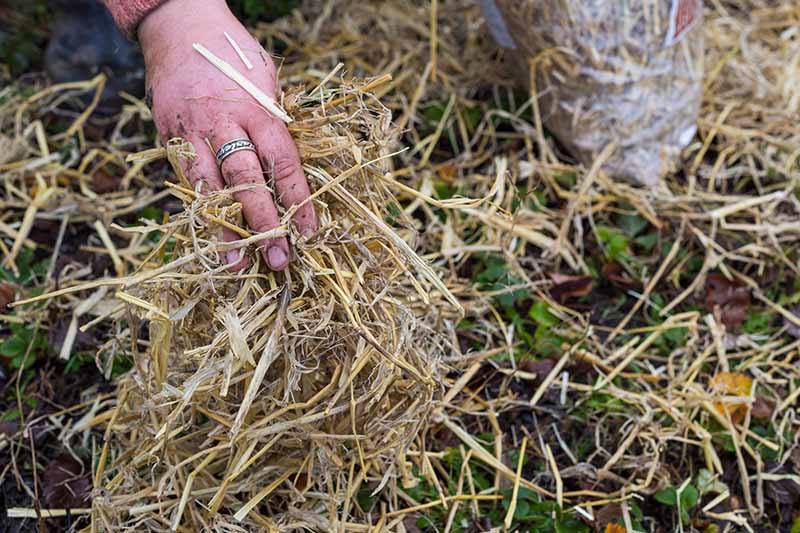
To apply mulch, drop it around and over the plants by loose handfuls. The pieces of straw or pine needles should separate as they fall, creating airy heaps, rather than tight clumps.
Completely bury all visible foliage beneath a continuous cover of mulch, all the way down the rows, or to the edges of the beds, raised beds, or containers.
For those growing in the garden, the pros at Iowa State University Extension and Outreach recommend an application of three to five inches of mulch.
They recommend six to eight inches in raised beds, especially pyramid planters, because the soil temperature becomes even colder than ground soil.
Some folks prefer to lay mulch when rain is in the forecast, to help hold it in place.
If you’re in an especially windy locale, you may want to anchor the mulch in your rows and beds with chicken wire. You can use bricks, rocks, or stakes to hold the chicken wire in place.
Regardless of when you lay it, or if you anchor it, mulch will compact over time and you may need to make additional applications during the winter months.
If you are growing your strawberries in barrels or pots, you can move them into storage in a cold shed or unheated basement or garage. Wrap the containers loosely in burlap, and fill the sides and top with six to eight inches of straw.
Berry On
That’s all there is to it. To recap, there are four steps to take to prepare your strawberries for winter’s onslaught:
- Renovate after harvesting.
- Fertilize with a balanced product.
- Water an inch per week until first frost.
- Apply mulch liberally and loosely after first frost.
And then, one dry day in early spring, after the winter winds have ceased to howl and the snow has finally melted, gently pull back the mulch.
If you see green shoots, it’s time to remove the mulch and let them bask in the sunshine. If not, try again soon.
What should you do with the mulch?
Rake it into the aisles between rows, to soak up spring rain and make walking less muddy. Leave some tucked around the sprouts to inhibit weeds, aid in moisture retention, and keep future berries up off the dirt.
Keeping mulch near is also handy when a late-season frost threatens, for short-term protection in a pinch.
We hope that winterization is soon a routine part of strawberry care in your garden, so you can weather the cold months with confidence, and berry on!
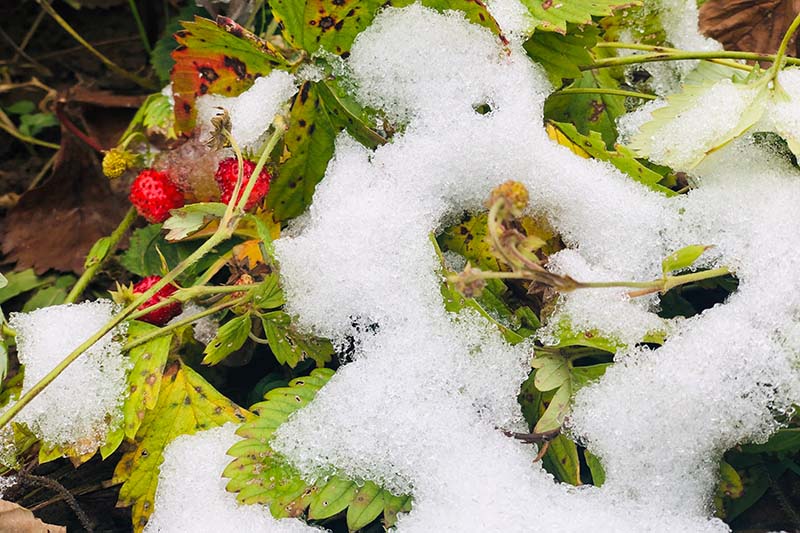
Have you successfully overwintered your strawberry plants? Share your tips in the comments section below.
And for more information about growing strawberries, check out these guides next:
- 35 of the Best Strawberry Varieties for Home Gardeners
- How to Control Gray Mold (Botrytis Rot) on Strawberries
© Ask the Experts, LLC. ALL RIGHTS RESERVED. See our TOS for more details. Uncredited photos: Shutterstock.

I noticed today that the straw I used to winterize my strawberry plants is very stinky and has mold all over it when I lift it up – is this going to damage my plants? Should I take it off and apply new straw? I live in zone 6 so it was recommended to winterize. I’m worried this is going to kill everything!
Hi Traci- There may be several factors at play. First, strawberries grow best on soil that is mounded up. Straw mulch should be fresh. Straw mulch should be applied by loose handfuls and slowly mounded up, to permit air to circulate through it. It’s possible that your strawberry soil is more of a depression than a mound, and it is holding water. The straw may have been tainted with fungal spores from the start, and they activated in the oversaturated soil. The straw may be too dense to allow water to drain off and has become a breeding ground for… Read more »
I have a 1 year old strawberry plant in a hanging pot. I live in Brunswick, Maryland. Can I just cut off the runners before the first frost and hang it on the patio under my deck? Do I need to do some sort of “renovation” to the plant, first?
…and, of course, bring the plant inside if we have an extended freezing spell….
Hello Chris – You can trim the runners, fertilize with a 10-10-10 product, water, and wait for the foliage to wilt and turn brown. Keep watering until the temperature is predicted to dip to freezing. Let the plant experience a few days of 32°F temperatures to ensure dormancy. At this point, snip off the brown, withered foliage and discard it. Fill the pot with straw mulch. Wrap the pot loosely in burlap, and fill the space between the pot and the burlap with more straw. It would be best to keep the pot against a wall, rather than hanging up,… Read more »
2021 was my first year gardening. I setup a 6 ft x 3 ft raised bed. during the spring I planted some strawberry plants bought at a big box store, some root starters from online and some were given to me by a friend who had extra. So I may have all 3 types of strawberry plants june-bearing, ever-bearing and day-neutral all mixed up in the same bed because I did not know there were different types at the time. It’s September 30th and our first frost in Kansas City is normally October 28th. Is it too late to prune?… Read more »
Hi Melody –
We’re so happy you enjoyed the article.
Unfortunately, it’s too late to prune and fertilize strawberries. Continue to water until the first freeze is predicted.
Apply mulch in late November or early December, when plants are hardened off, or acclimated to the cold.
I planted strawberries in a raised bed this spring. Things got wild with our kids and other garden and I didn’t do a thing to my strawberries. Now I am trying to catch up. They have taken over the raised bed which wasn’t the plan initially but I think it’s a good idea because I have room and I can just have a strawberry bed. So I keep reading I need to snip the runners. I only planted three plants this spring. If I am wanting the strawberry plants to take over the raised bed should I still snip runners?… Read more »
I live in Winnipeg, and we have snow in the winter. Do I still need mulch? And do I cut off the foliage after it freezes?
Hi Marlene –
Unless you are growing June-bearing plants, which set their buds in fall, you can cut the plants back in late fall. If you were still getting berries in September, you have either ever-bearing or day-neutral plants.
Trim the runners and thin the plants out to keep them strong and minimize crowding.
Once they are dormant, and before the temperature drops to 20°F, apply a generous five inches of loose mulch on a dry day. Without mulch, strawberry plants are susceptible to fatal crown damage.
Hi Charlie –
It’s fine to let the runners fill out a “matted row” this year, and prune next year’s wayward runners in order to keep the plants strong.
You can also remove and pot up runners to plant out in the spring, if you like.
I have no idea what kind of 13 plants I have grown, except that I was still getting a few strawberries 3 weeks ago in mid-September. Wondering if I need to prune them, or what to do with them before winter, as different articles makes it confusing. This is Winnipeg, and we have snow, so do we need mulch, too? Should I have thinned them out? I started with 9 and have 13 now. Did they multiply in the summer?
Hi! I bought June bearing and ever bearing plants last spring! This fall I made a raised bed for the June bearing and transplanted them, then pruned them to about 1 inch, bought straw for winter (glad I read to wait until nov-dec to put out) which comes to my questions 1) Should I have pruned the plants as late as oct 20 since they bud in fall? If I pruned to late how does this compromise next years harvest? As for my ever bearing I have not pruned them yet, should I? 2) I fed them in august, am… Read more »
And thank you for the very informative article! I plan to print it and use for reference!
Hi Brenda –
We’re so glad you found the article informative.
The June-bearing plants may not fruit next season, as they would have already formed buds when they were pruned in October.
As for the ever-bearing, you can cut them back in late fall.
Fertilize in the fall, at least a month before your average fall frost date, and again in the spring.
And remember not to apply mulch until the plants are dormant.
Hi!
I have always covered strawberry plants with pine needles and they did good, taking them off in the spring.
Last year I began “Back to Eden” gardening.
I put wood chips (from a chipped pine tree w/needles) all over the strawberries, covering any green. I left them on in the spring. The older berry plants died (which I was hoping would happen) and the healthy plants came through. They were already mulched in the spring from the wood chips and my strawberries were the best they have ever been!
Always something new to learn!
Hello Greenslade Laurie, I like this idea and am so glad it worked out for you. It’s also nice to think about springtime strawberries as the temps start to plummet. Happy gardening!
How deep did you cover the strawberries with wood chips? I’m trying to find good insight on this because this is what I plan to do. And what zone are you in? Many thanks!
If I have strawberries in a plastic pot in Saskatchewan Canada how can they be winterized?
Hello Gerald! Yes, it’s definitely worth a shot. I can’t improve on Nan Schiller’s advice to another gardener who asked a similar question on this thread, only that gardener had strawberries in hanging baskets. Here’s what she had to say: You can trim the runners, fertilize with a 10-10-10 product, water, and wait for the foliage to wilt and turn brown.Keep watering until the temperature is predicted to dip to freezing. Let the plant experience a few days of 32°F temperatures to ensure dormancy.At this point, snip off the brown, withered foliage and discard it. Fill the pot with straw… Read more »
I planted 50 Sweet Charlie plants in my greenhouse in October and every plant lived and thrived. In mid December I started to get a few blooms. Around December 27th I noticed there were several plant with berries on them about 3/8″ in diameter. I’m wondering if I should remove them or let them grow. I wasn’t sure how it would affect spring berry growth.
Hello Chuck –
Strawberries need 200 to 300 chill hours. You can harvest now, or let them grow a little larger, and them cool the greenhouse down to about 45°F to provide the stimulus for spring blooming and fruiting.
I am winterizing my potted strawberry plants in my
unheated garage in WI. I cut away the brown leaves, but some leaves are still green and it is now the beginning of February. Does this mean my garage is not cold enough for them to be dormant? Should I move them outside for a few days? They are in huge Mr. Stacky planters.
Hi Veronica –
For your zone, outdoor potted or in-ground plants would generally be brown, withered, and dormant by November, at which point, you would bring them inside. It sounds like you may have renovated your plants and brought them inside before they were dormant. If you can expose them to temperatures between 45 and 32°F for 200 to 300 hours, and water just enough to keep the soil slightly moist, there’s still time for them to enter dormancy to stimulate spring blooming and fruiting.